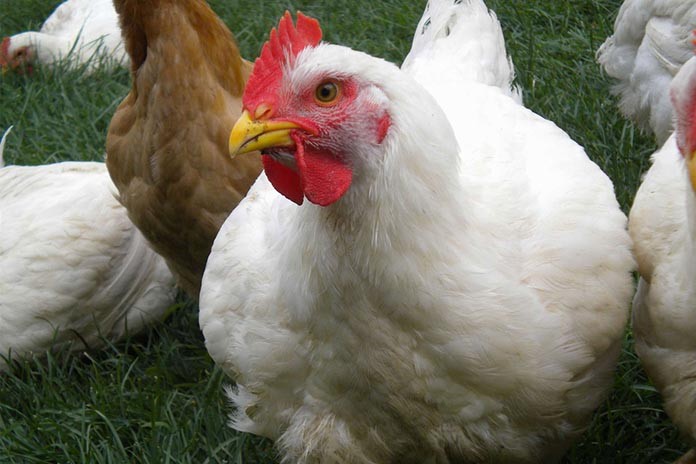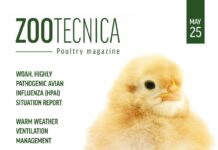
The intestinal epithelial physical barrier is the most critical element of maintaining an intact intestinal barrier and made up of a layer of columnar epithelial cells and intercellular junctional complexes including tight junctions, adherens junctions and desmosomes.
Tight junctions (TJ), which are formed by proteins including claudins, occludin, junctional adhesion molecule and zonula occludens (ZO), are primarily responsible for the permeability of the paracellular pathway. The function of the intestinal barrier function in poultry is evaluated by measuring intestinal permeability.
Few studies have shown the developmental profile of intestinal barrier function and tight junction proteins in the intestinal epithelium of chicks in embryonic phase or/and the early post-hatch period. Several feed additives, including nutrients (i.e. Zn), probiotics, prebiotics, functional polysaccharide, enzymes and epidermal growth factor, were shown to regulate intestinal barrier function by modifying expression and localization of TJ proteins.
The animal intestine has the roles of absorbing nutrients and also acting as a barrier to prevent pathogens and toxins from entering into the body and potentially causing disease. Injured intestinal barrier is characterized by increased intestinal permeability, which allows luminal antigenic agents (e.g., bacteria, toxins, and feed-associated antigens) to “leak” across the epithelium to sub-epithelial tissues, to result in inflammation, malabsorption, diarrhea, and potentially systemic disease. In the post-AGP (antibiotic growth promoters) era, nutritional solutions to maintain the integrity of the intestinal barrier is of great importance to get proper functioning of the epithelial cells and to prevent the entry of pathogenic bacteria.
The intestinal epithelial physical barrier
The intestinal epithelium forms the largest and most important barrier between internal and external environments of animals. The intestinal epithelial barrier is made up of a layer of columnar epithelial cells that forms the first line of defense between the intestinal lumen and inner milieu.
The intestinal epithelial cells are mainly absorptive enterocytes (over 80%) but also include entero-endocrine, goblet, and Paneth cells. The epithelium allows the absorption of nutrients while providing a physical barrier to the permeation of pro-inflammatory molecules, such as pathogens, toxins, and antigens, from the luminal environment into the mucosal tissues and circulatory system. The epithelial selective permeability includes two pathways: the transcellular and the paracellular pathway. The transcellular pathway is involved in the absorption and transport of nutrients, including sugars, amino acids, peptides, fatty acids, minerals, and vitamins. As the cell membrane is impermeable, this process is predominantly mediated by specific transporters or channels located on the apical and basolateral membranes.
The paracellular pathway is associated with transport in the intercellular space between the adjacent epithelial cells. These epithelial cells are tightly bound together by intercellular junctional complexes that regulate the paracellular permeability and are crucial for the integrity of the epithelial barrier. These junctions allow the passage of fluids, electrolytes, and small macromolecules, but inhibit passage of larger molecules.
The junctional complexes consist of the tight junctions, gap junctions, adherens junctions, and desmosomes. Tight junctions are the most apical and are primarily responsible for controlling permeability of the paracellular pathway. Adherens junctions are located beneath the tight junctions and are involved in cell-cell adhesion and intracellular signaling. Both tight junctions and adherens junctions (together known as the apical junctional complex) are associated to the actin cytoskeleton. Desmosomes and gap junctions are involved in cell-cell adhesion and intracellular communication, respectively. The cytoskeleton is an intricate structure of protein filaments that extends throughout the cytosol that is essential for maintaining the structure of all eukaryotic cells. Disruption of the cytoskeleton is linked to the loss of intestinal barrier integrity.
Tight junctions are formed by protein dimers that span the space between adjacent cell membranes. There are over 50 proteins with well recognized roles in tight junction formation. These proteins comprise four integral transmembrane proteins (e.g. occludin, claudins, junctional adhesion molecules (JAM) and tricellulin), and cytosolic scaffold proteins, such as zonula occludens (ZO) proteins. The extracellular domains of the transmembrane proteins form the selective barrier by hemophilic and heterophilic interactions with the adjacent cells.
The intracellular domains of these transmembrane proteins interact with ZO proteins, which in turn anchor the transmembrane proteins to the perijunctional actomyosin ring. The interaction of TJ proteins with the actin cytoskeleton is vital to the maintenance of TJ structure and function. In addition, the interaction of the TJ complex with the actomyosin ring permits the cytoskeletal regulation of TJ barrier integrity.
The function of occludin is not yet fully understood, but numerous studies using animals and cell cultures indicate that it is required for TJ assembly and barrier integrity in the intestinal epithelia. Occludin has been linked to the regulation of intermembrane diffusion and paracellular diffusion of small molecules. The claudin proteins are considered to be the structural backbone of TJ. Claudins consist of at least 24 members in humans and mice, and each isoform shows a unique expression pattern in tissues and cell lines. In contrast to their structural similarities, claudins perform different functions and can be roughly divided into two types: those involved in barrier formation (decreasing paracellular permeability) and those in channel pores (increasing paracellular permeability).
In the intestines, claudin-1, -3, -4, -5, -8, -9, -11, and -14 can be categorized as barrier-forming claudins, while claudin-2, -7, -12, and -15 are pore-forming claudins. Several plaque proteins have been identified, including the zonula occludens (ZO) proteins, ZO-1, ZO-2, and ZO-3. Plaque proteins potentially play a central role in TJ regulation, because they can cause reorganization of the cytoskeleton. Claudin-1, claudin-2 , claudin-3, claudin-5, claudin-16, ZO-1, ZO -2 and occludin are reported in poultry.
TJ are not static barriers but highly dynamic structures that are constantly being remodeled due to interactions with external stimuli, such as food residues and pathogenic and commensal bacteria. Regulation of the assembly, disassembly, and maintenance of TJ structure is influenced by various physiological and pathological stimuli. Signaling pathways involved in TJ regulation, and interactions between transmembrane proteins and the actomyosin ring are controlled by several signaling proteins, including protein kinase C (PKC), mitogen-activated protein kinases (MAPK), myosin light chain kinase (MLCK), and the Rho family of small GTPases.
Assessment of the epithelial physical barrier function in poultry
a) Intestinal permeability
Intestinal permeability is defined as the non-mediated diffusion of large (i.e., molecular weight >150 Da), normally restricted molecules from the intestinal lumen to the blood. The primary means of determining intestinal permeability in humans or animals is by measuring the passage of high molecular weight probes across the gastrointestinal tract barrier. In humans, this involves ingestion of a solution containing nontoxic, non-metabolizable substances (such as sucrose, lactulose, sucralose) and assessing their excretion in the urine. The appearance of probes in the urine indicates loss of barrier function in the gastrointestinal tract. However, that method is unsuitable for poultry because of the mixture of urine and feces. In animal models including poultry, intestinal permeability is usually determined by infusing fluorescent probes, such as fluoroisothiocyanate (FITC)-dextrans, into the intestinal area of interest and measuring plasma concentrations over time. The probe horseradish peroxidase was also reported. The Ex vivo Ussing chamber is the most sensitive to test the intestinal permeability by measuring transepithelial electrical resistance (TER), as it reflects the opening of the tight junctions between epithelial cells and the paracellular permeability of the intestinal mucosa.
b) Bacterial translocation
Bacterial translocation is defined as the passage of viable bacteria from the intestinal tract through the epithelial mucosa into extra-intestinal organs. Impaired mucosal surfaces can increase vulnerability of the intestinal epithelium with an augmented risk of bacterial and viral penetration, or bacterial overgrowth in the in the intestine. The disruption in barrier functions was associated with viral and bacterial translocation across the epithelial monolayers.
c) Plasma LPS concentrations
LPS is a highly pathogenic component of the walls of gram negative bacteria and is found in the intestinal tract in high concentration. Its presence in the portal blood of animal models indicates passage from the intestinal lumen to the circulation. Increased LPS concentration in the systemic circulation likely indicates severe intestinal barrier dysfunction.
Development of the epithelial physical barrier
Kawasaki et al. (1998) determined the developmental expression of occludin in the gastrointestinal tract of 3- to 21-day-old chick embryos and reported that occludin mRNA was first detected by RT–PCR in the chick embryo on day 3 of incubation, by northern blot analysis on day 4, and by western blot analysis on day 5, suggesting that synthesis of occludin begins in the chick embryo at a very early stage of development. The immune-histochemical assay revealed that occludin began to be weakly expressed only along the apical surface of the gastrointestinal epithelium of the 4-day-old chick embryo. As the embryo developed, the immunoreactivity gradually became stronger and formed more complex networks near the apical surface, which indicated that the developmental expression of occludin in the gastrointestinal tract is closely correlated with the morphological as well as functional development of the tight junction.
Roberts et al. (2005) reported that the small intestinal epithelial barrier function of broiler chicks hasn’t developed well at hatching, and the jejunal TER increased more than 3-folds and the ileal TER increased one-fold during d2 to d11 of age. Jejunal occludin expression increased linearly with age, but did not reach a plateau by d11, even though no effects of age on ileal occludin or on zonula occludens-2 expression were observed.
Their work shows that the epithelial barrier function of the ileum is not fully developed in broiler chicks until later than d 14 of age for the ileum. More research are required to develop nutritional solutions beneficial for the small intestinal barrier function development and gut health.
Modification of the epithelial physical barrier by dietary factors in poultry
a) Zinc
The importance of Zn to intestinal development and function has been demonstrated in many studies, dietary Zn supplementation reduced gut lesion scores and the intestinal permeability and increased expression of ZO-1 and occludin in mammals. Zn deprivation induced a decrease of TER and altered tight and adherens junctions. Zhang et al. (2012) reported that Zn (as ZnSO4) up-regulated occludin and claudin-1 mRNA expression in the ileum and tended to reduce plasma endotoxin levels in the chickens challenged with Salmonella Typhimurium, and indicated that regulation of occludin and claudin-1 expression by Zn could be involved in ameliorating the increased intestinal permeability induced by Salmonella Typhimurium challenge. Hu et al. (2013) showed that supplemental ZnO or ZnSO4 did not affect ileal and colonic barrier function and intestinal microflora in broiler chickens, however supplemental 60 mg of Zn/kg as ZnO-MMT (zinc oxide-montmorillonite hybrid) increased colonic TER values, and reduced colonic probe mannitol permeability as well as ileal or colonic inulin permeability of the chickens.
b) Probiotics and Prebiotics
In the study by Rajput et al. (2013), compared to treatments with Saccharomyces boulardii and Bacillus subtilis B10, the tight junctions of jejunum and ileum of broilers were comparatively loose in the control group, and both Saccharomyces boulardii and Bacillus subtilis B10 improved the epithelial tight junctions through increasing occludin, claudin-2, and claudin-3 mRNA expression levels in the intestine of the broilers. CAO et al. (2014) reported that L. fermentum 1.2029 was able to ameliorate the severity of necrotic enteritis lesions and inflammation and improved the epithelial barrier through increasing claudin-1 and occludin levels in the necrotic enteritis -infected chickens.
Heat stress not only negatively affected the intestinal microbiota balance, also decreased the jejunal TER and increased the jejunal paracellular permeability of FITC-dextrans, and which was correlated the down-regulated jejunal protein levels of occludin and ZO-1 in the broilers. Supplemental probiotic mixture containing Bacillus licheniformis, Bacillus subtilis and Lactobacillus plantarum increased the jejunal protein level of occludin in the broilers. That indicated that dietary addition of the probiotic mixture was effective in partially ameliorating intestinal barrier dysfunction induced by heat stress in broilers.
Song et al. (2013) also reported that supplemental cello-oligosaccharide, a functional oligosaccharide obtained from plant cellulose, increased the jejunal villus height and villus height to crypt depth ratio, as well as decreased jejunal paracellular permeability of FITC- dextran in the broiler chickens.
c) Functional polysaccharides
β-1,3/1,6-glucan from Saccharomyces cerevisiae has beneficial effects on both the innate and acquired immune systems, and clearance of pathogens such as Salmonella, Escherichia coli and coccidiosis in broiler chickens. The work of Shao et al. (2014) showed that dietary β-1,3/1,6-glucan supplementation could attenuate the intestinal mucosal barrier impairment in the broiler chickens challenged with Salmonella Typhimurium, and that could be related to the increased mRNA expression of claudin-1 and occludin, and the increased goblet cell numbers and sIgA level in the jejunum of the broiler chickens.
Parson et al. (2014) reported that in chickens, dietary supplementation with soluble non-starch polysaccharide (NSP) plantain NSP reduced invasion by S.Typhimurium, as reflected by viable bacterial counts in splenic tissue, and plantain NSP inhibited adhesion of S.Typhimurium to a porcine epithelial cell-line and to primary chick caecal crypts in vitro.
d) Enzymes
Clostridium perfringens challenge increased the intestinal lesion score and also resulted in passive transcellular permeability and higher plasma endotoxin in the chickens, and dietary addition of xylanase or enzyme complex containing xylanase, glucanase and mannanase could alleviate the alteration caused by C. perfringens infection, indicating that dietary enzyme supplementation could benefit for gut barrier integrity ofthe C. perfringens-challenged chickens.
Lysozyme as a natural antimicrobial protein occurs in a number of animal secretions and is considered an important component of the innate immune system. The addition of exogenous lysozyme significantly reduced the concentration of Clostridium perfringens in the ileum and the intestinal lesion scores, and inhibited the overgrowth of E. coli and Lactobacillus in the ileum and intestinal bacteria translocation to the spleen of chickens challenged with Clostridium perfringens, suggesting that exogenous lysozyme could be used to improve the intestinal barrier function of chickens.
e) Epidermal growth factor (EGF)
EGF is a small amino acid peptide with a broad range of bioactivities on the intestinal epithelium, including the stimulation of cellular proliferation, differentiation, and intestinal maturation. In chickens, EGF reduced jejunal C. jejuni colonization and alleviated the dissemination of C. jejuni to the liver and spleen. In the in vitro study, the pretreatment with EGF abolished the C. jejuni-induced intestinal epithelial abnormalities, such as disruption of tight junctional claudin-4, increasing of transepithelial permeability and the translocation of noninvasive Escherichia coli C25.
f) Others
Other dietary factors such as threonine, glutamine, and flavonoids were also reported to regulate intestinal epithelial barrier in animals or cell lines in vitro, but few reports in poultry were found. More nutritional solutions to improve intestinal barrier function and the underlying molecular mechanisms are needed to be investigated.

















